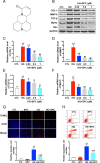Sophocarpine Suppresses NF-κB-Mediated Inflammation Both In Vitro and In Vivo and Inhibits Diabetic Cardiomyopathy
- PMID: 31736745
- PMCID: PMC6836764
- DOI: 10.3389/fphar.2019.01219
Sophocarpine Suppresses NF-κB-Mediated Inflammation Both In Vitro and In Vivo and Inhibits Diabetic Cardiomyopathy
Abstract
Diabetic cardiomyopathy (DCM) is a leading cause of mortality in patients with diabetes. DCM is a leading cause of mortality in patients with diabetes. We used both in vitro and in vivo experiments to investigate the hypothesis that sophocarpine (SPC), a natural quinolizidine alkaloid derived from a Chinese herb, could protect against DCM. We used hyperglycemic myocardial cells and a streptozotocin (STZ)-induced type 1 diabetes mellitus mouse model. SPC protected myocardial cells from hyperglycemia-induced injury by improving mitochondrial function, suppressing inflammation, and inhibiting cardiac apoptosis. The SPC treatment significantly inhibited the activation of nuclear factor kappa-light-chain-enhancer of activated B cells (NF-κB) signaling in high-glucose-stimulated inflammatory responses. Moreover, SPC significantly slowed the development and progression of DCM in STZ-induced diabetic mice. These results show that SPC suppresses NF-κB-mediated inflammation both in vitro and in vivo and may be used to treat DCM.
Keywords: NF-κB; cardiomyopathy—diagnostics; diabetes; inflammation; sophocarpine.
Copyright © 2019 Zou, Wang, Liu, Wang, Hu, Xiong, Wu, Shen and Yang.
Figures





Similar articles
-
Focal adhesion kinase induces cardiac remodeling through NF-κB-mediated inflammatory responses in diabetic cardiomyopathy.Int Immunopharmacol. 2023 Jul;120:110280. doi: 10.1016/j.intimp.2023.110280. Epub 2023 May 20. Int Immunopharmacol. 2023. PMID: 37216798
-
Blockage of DCLK1 in cardiomyocytes suppresses myocardial inflammation and alleviates diabetic cardiomyopathy in streptozotocin-induced diabetic mice.Biochim Biophys Acta Mol Basis Dis. 2024 Jan;1870(1):166900. doi: 10.1016/j.bbadis.2023.166900. Epub 2023 Sep 29. Biochim Biophys Acta Mol Basis Dis. 2024. PMID: 37778481
-
Luteolin protects against diabetic cardiomyopathy by inhibiting NF-κB-mediated inflammation and activating the Nrf2-mediated antioxidant responses.Phytomedicine. 2019 Jun;59:152774. doi: 10.1016/j.phymed.2018.11.034. Epub 2018 Nov 28. Phytomedicine. 2019. PMID: 31009852
-
Kaempferol attenuates hyperglycemia-induced cardiac injuries by inhibiting inflammatory responses and oxidative stress.Endocrine. 2018 Apr;60(1):83-94. doi: 10.1007/s12020-018-1525-4. Epub 2018 Feb 1. Endocrine. 2018. PMID: 29392616
-
A Review on the Natural Products in Treatment of Diabetic Cardiomyopathy (DCM).Rev Cardiovasc Med. 2024 May 13;25(5):165. doi: 10.31083/j.rcm2505165. eCollection 2024 May. Rev Cardiovasc Med. 2024. PMID: 39076497 Free PMC article. Review.
Cited by
-
Sophocarpine Alleviates Injury-Induced Intima Hyperplasia of Carotid Arteries by Suppressing Inflammation in a Rat Model.J Clin Med. 2021 Nov 22;10(22):5449. doi: 10.3390/jcm10225449. J Clin Med. 2021. PMID: 34830730 Free PMC article.
-
Qing-Luo-Yin Alleviated Experimental Arthritis in Rats by Disrupting Immune Feedback Between Inflammatory T Cells and Monocytes: Key Evidences from Its Effects on Immune Cell Phenotypes.J Inflamm Res. 2021 Dec 30;14:7467-7486. doi: 10.2147/JIR.S346365. eCollection 2021. J Inflamm Res. 2021. PMID: 35002280 Free PMC article.
-
Esculeoside A Decreases Diabetic Cardiomyopathy in Streptozotocin-Treated Rats by Attenuating Oxidative Stress, Inflammation, Fibrosis, and Apoptosis: Impressive Role of Nrf2.Medicina (Kaunas). 2023 Oct 14;59(10):1830. doi: 10.3390/medicina59101830. Medicina (Kaunas). 2023. PMID: 37893548 Free PMC article.
-
The immunology of diabetic cardiomyopathy.Front Endocrinol (Lausanne). 2025 Apr 7;16:1542208. doi: 10.3389/fendo.2025.1542208. eCollection 2025. Front Endocrinol (Lausanne). 2025. PMID: 40260277 Free PMC article. Review.
-
Oxidative Stress Signaling Mediated Pathogenesis of Diabetic Cardiomyopathy.Oxid Med Cell Longev. 2022 Jan 22;2022:5913374. doi: 10.1155/2022/5913374. eCollection 2022. Oxid Med Cell Longev. 2022. PMID: 35103095 Free PMC article. Review.
References
-
- Guo Y., Zhuang X., Huang Z., Zou J., Yang D., Hu X., et al. (2018). Klotho protects the heart from hyperglycemia-induced injury by inactivating ROS and NF-kappaB-mediated inflammation both in vitro and in vivo . Biochim. Biophys. Acta Mol. Basis Dis. 1864 (1), 238–251. 10.1016/j.bbadis.2017.09.029 - DOI - PubMed
LinkOut - more resources
Full Text Sources

